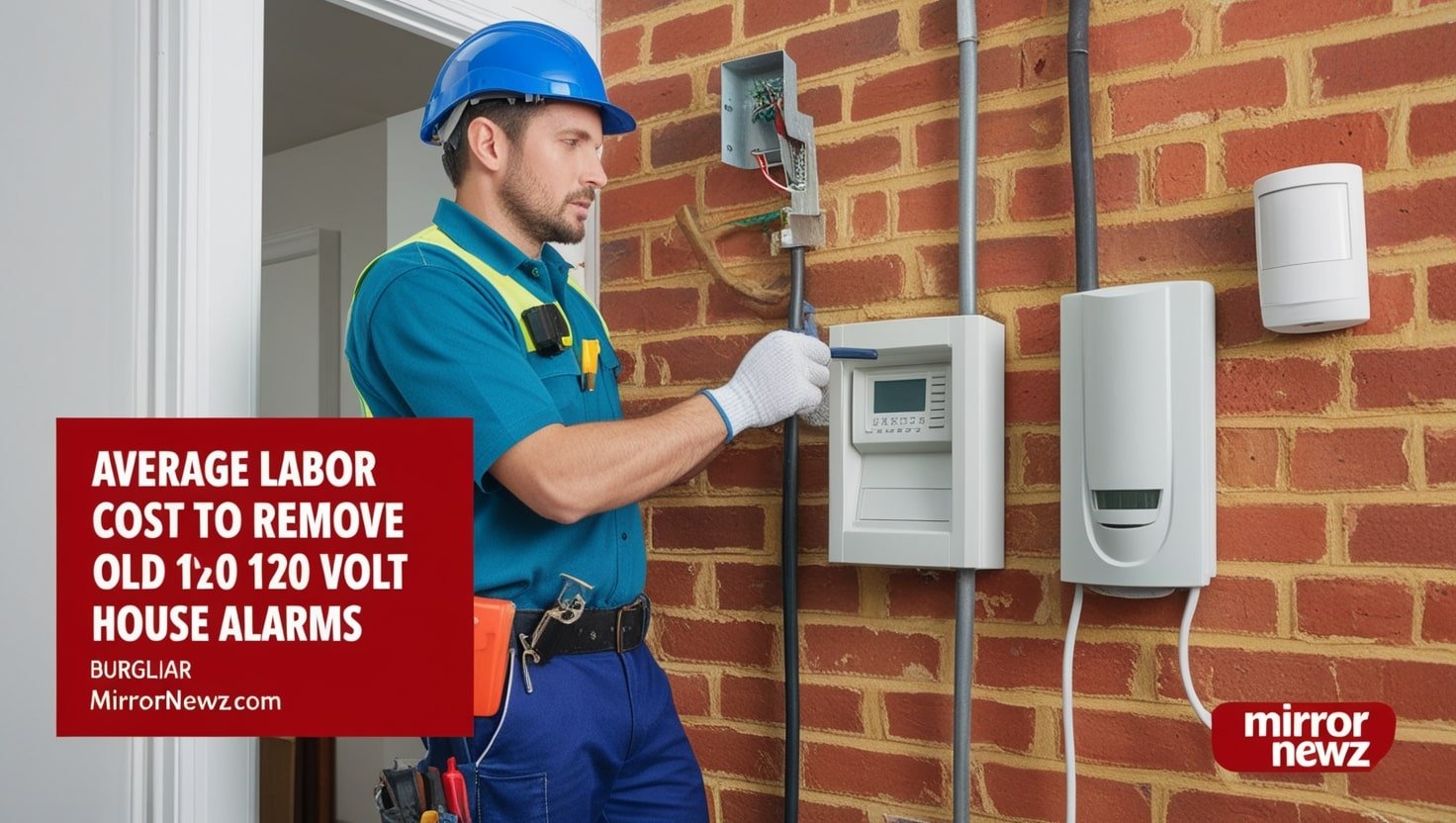Home security is a priority for many homeowners, and over the years, the technology used in home alarm systems has evolved significantly. However, as systems become outdated or homeowners upgrade to newer models, there may be a need to remove old 120 volt house alarms. One of the most common questions when considering this task is the average labor cost to remove old 120 volt house alarms. In this comprehensive article, we will explore the factors that influence this cost, the steps involved in removing these systems, and the importance of professional installation versus DIY efforts.
What is a 120 Volt House Alarm System?
A 120 volt house alarm system is a type of home security system that is powered by a standard 120-volt AC electrical outlet, rather than relying on batteries. These systems were common in older homes and offer basic features for detecting intrusions, fire, or carbon monoxide levels. Typically, these alarms are hardwired into the home’s electrical system and can include smoke detectors, carbon monoxide detectors, and motion sensors.
Because these systems are hardwired, removing them can be more complex than simply disconnecting battery-powered alarms. The removal process often requires disconnecting wires from the electrical system and properly disposing of or recycling the old system. If you’re considering removing an old 120 volt house alarm, understanding the average labor cost to remove old 120 volt house alarms is essential.
Factors That Influence the Average Labor Cost to Remove Old 120 Volt House Alarms
The average labor cost to remove old 120 volt house alarms can vary depending on several factors. It’s important to consider these aspects when budgeting for this project to avoid any surprises. Here are some of the main factors that influence the cost:
Complexity of the System
The complexity of the alarm system plays a major role in determining the labor cost. A simple system with just a few components, such as a single smoke detector, may take less time and effort to remove, leading to a lower labor cost. However, if the system includes multiple detectors, motion sensors, and control panels, it will take longer to remove the components and disconnect them properly, increasing the labor cost.
Additionally, the complexity of the wiring and integration with other systems in the home can also impact the cost. If the old alarm system is connected to other home automation or security systems, the removal process becomes more intricate, requiring more time and expertise.
Location of the Alarm Components
The location of the alarm components can affect the labor cost to remove old 120 volt house alarms. If the system is installed in easily accessible areas, such as near a ceiling or along walls that can be easily reached with a ladder, the job will be faster and more straightforward. On the other hand, if the system includes alarms that are difficult to access, such as in high ceilings or behind walls, additional labor and equipment may be necessary to safely remove the system.
If the wiring needs to be traced and disconnected from electrical panels or junction boxes, the labor cost could also rise. The more challenging the location, the more work is required, and this adds to the overall cost of removal.
Professional vs. DIY Removal
When considering the average labor cost to remove old 120 volt house alarms, it’s important to decide whether to hire a professional or attempt the job as a DIY project. While a professional will have the necessary skills, tools, and experience to complete the job quickly and safely, attempting to remove the system yourself may reduce the immediate labor cost. However, removing a hardwired alarm system can be dangerous if not done properly, especially when dealing with electrical wiring.
In many cases, hiring a professional may seem like a higher upfront cost, but it ensures that the system is removed without damaging the electrical wiring or the home’s infrastructure. Professionals are also knowledgeable about local codes and regulations, ensuring that everything is done safely and legally.
Additional Services
In some cases, the labor cost to remove old 120 volt house alarms may include additional services. For example, if you plan to install a new alarm system after removing the old one, there may be extra costs involved in preparing the space for the new installation. This could include patching up holes in the wall, repairing any damage caused during the removal process, or ensuring that the electrical wiring is up to code for the new system.
Some professionals may also offer disposal services, which could include recycling or properly disposing of the old system. These additional services can contribute to the overall labor cost.
The Typical Labor Cost to Remove Old 120 Volt House Alarms
On average labor cost to remove old 120 volt house alarms, the labor cost to remove old 120 volt house alarms ranges from $100 to $250 per hour. This range depends on the complexity of the system and the factors mentioned earlier. Most alarm system removal projects will take between one and three hours, so homeowners can expect to pay anywhere from $150 to $750 for the removal process.The cost can also vary depending on the region and the company performing the work
Labor rates in urban areas or regions with a higher cost of living may be on the higher end of this range, while rural areas may have lower rates.For a simpler job, such as removing a single smoke detector or carbon monoxide detector, the labor cost may be on the lower end of the spectrum. However, for a more complex system that involves multiple devices and requires significant rewiring, the cost could rise to the higher end of the range.
Step-by-Step Process for Removing Old 120 Volt House Alarms
The process of removing an old 120 volt house alarm system typically involves several key steps. Understanding these steps can help you determine the amount of time and labor involved in the project, giving you a better idea of the potential costs.
Step 1: Turn Off the Power
average labor cost to remove old 120 volt house alarms Before removing any electrical components, it is crucial to turn off the power to the system to prevent any potential electrical hazards. This step involves shutting off the power at the breaker panel and confirming that the system is no longer receiving electricity.
Step 2: Disconnect the Alarm Components
Once the power is off, the technician will begin disconnecting the alarm components. This may include removing the smoke detectors, carbon monoxide detectors, or motion sensors from their mounts. Depending on the type of system, this could involve unscrewing screws or carefully prying the devices off their mounts.
Step 3: Disconnect the Wiring
After the components are removed, the next step is to disconnect the wiring. This involves cutting the wires that are connected to each device and ensuring that the electrical connections are properly terminated to prevent any issues in the future. If the system is integrated into the home’s electrical wiring, this step could be more complicated and may require professional expertise.
Step 4: Patch and Repair
Once the alarm system is completely removed, any holes or damage to the walls or ceilings will need to be patched and repaired. This is an additional step that may be necessary, especially if the system was mounted on drywall or other surfaces that require patching.
Step 5: Dispose of the Old System
Finally, the average labor cost to remove old 120 volt house alarms needs to be properly disposed of. Depending on the company, this could involve recycling the system’s components or disposing of them in accordance with local regulations. Proper disposal ensures that the system does not harm the environment or violate any laws regarding electronic waste.
Why You Should Hire a Professional to Remove Your Old 120 Volt House Alarm
While it might be tempting to try to remove the old alarm system yourself in order to save on labor costs, there are several reasons why hiring a professional is often the best option. Here are a few of the key benefits of professional installation:
Expertise and Experience
A professional technician has the expertise and experience to remove the system quickly and safely. They understand the complexities of dealing with electrical components and can avoid common pitfalls that DIYers may encounter.
Safety
Dealing with electrical systems can be dangerous if you don’t have the right training and tools. A professional will know how to safely disconnect the system, ensuring that no one is at risk of electrical shock or other hazards.
Compliance with Local Codes
In many areas, there are local building codes and regulations that govern the removal of hardwired alarm systems. A professional installer is familiar with these codes and will ensure that the removal is done legally and safely.
Time and Convenience
Removing an old alarm system can be time-consuming, especially if you are not familiar with the process. Hiring a professional saves you time and effort, allowing you to focus on other tasks while the system is removed.
Conclusion
Understanding the average labor cost to remove old 120 volt house alarms is crucial for budgeting and ensuring that the removal process goes smoothly. The cost can vary based on factors such as system complexity, location, and whether you choose to hire a professional or tackle the job yourself.
While DIY removal may seem appealing, it is often safer and more efficient to hire a professional, particularly if the system is complex or hardwired into your home’s electrical system. By considering the factors that influence labor costs and the benefits of professional removal, you can make an informed decision and ensure that your old alarm system is removed safely and efficiently.


